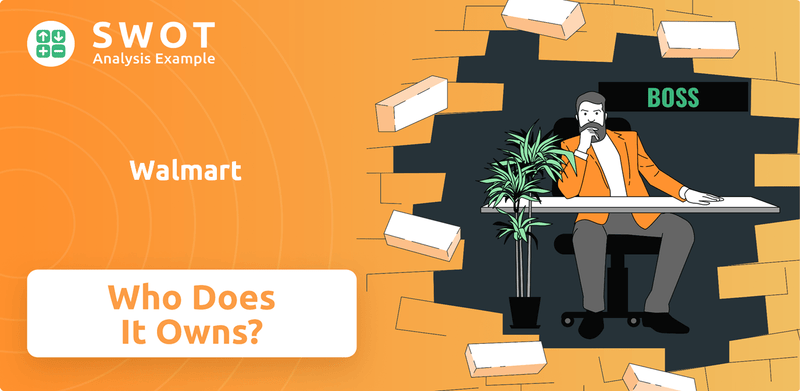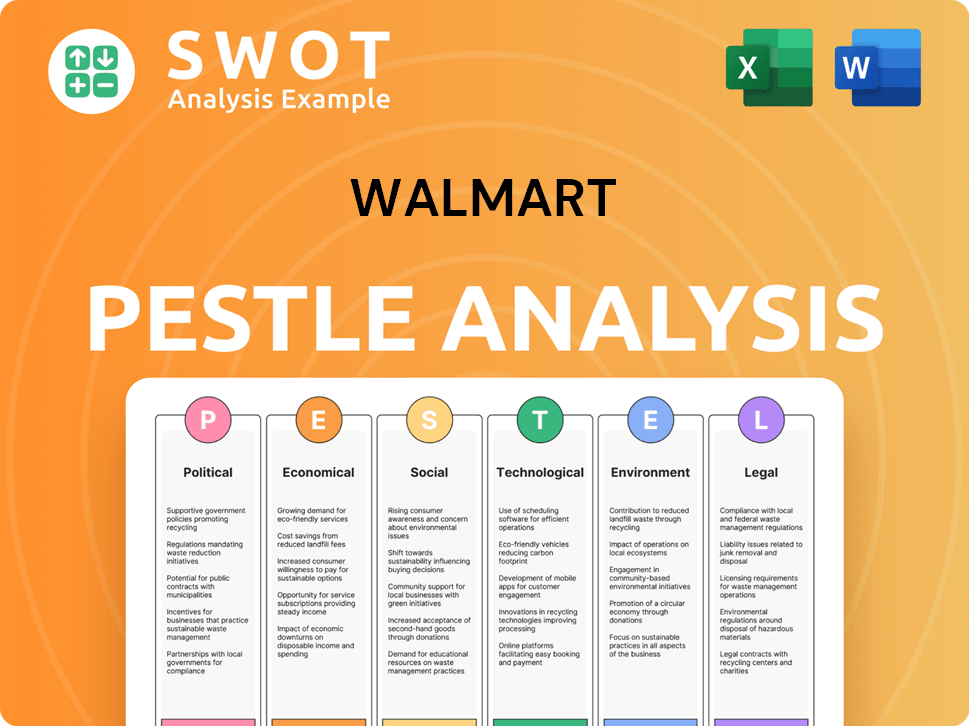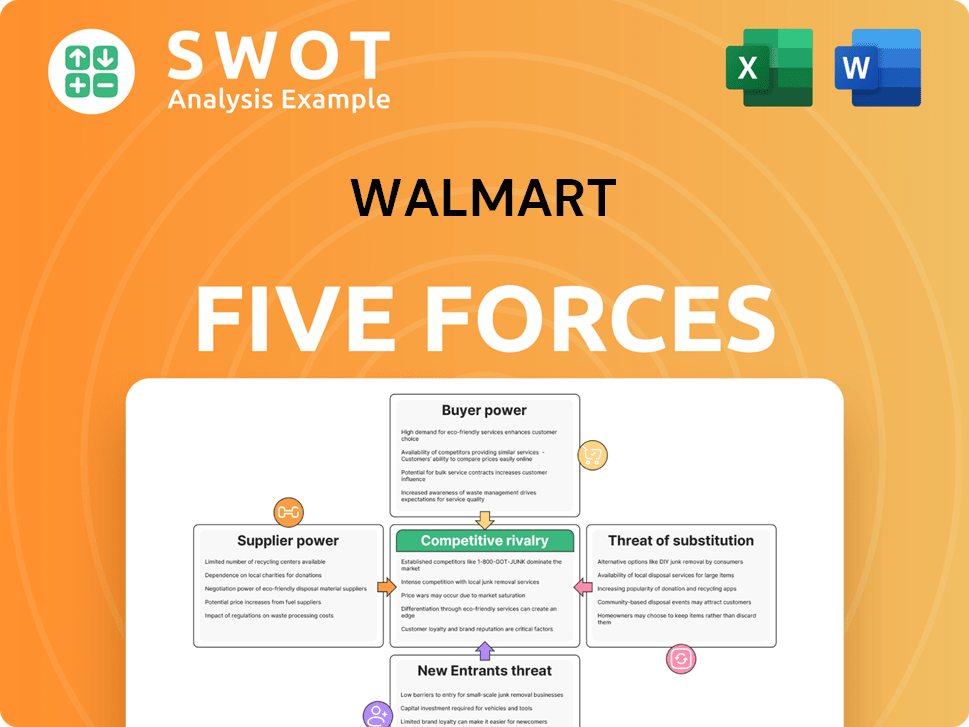Walmart Bundle
Who Really Owns Walmart?
Understanding the intricate web of Walmart SWOT Analysis and its ownership structure is crucial for anyone seeking to understand the retail giant's future. From its humble beginnings in Arkansas to its global dominance, Walmart's journey is a testament to the power of strategic ownership. Knowing who controls the company unveils insights into its decision-making, strategic direction, and overall market influence.

The question of "Who owns Walmart?" goes beyond simple stock ownership; it delves into the heart of its corporate governance and long-term vision. Examining the Walmart parent company and its shareholders reveals the forces shaping its strategies, from its everyday low prices to its expansion into e-commerce. Exploring Walmart's history of ownership and the influence of its executives provides a comprehensive view of this retail titan. This analysis will explore the Walmart ownership structure and the key players that define its present and future, including Walmart's largest shareholders, to help you understand how to invest in Walmart stock and what is Walmart's market capitalization.
Who Founded Walmart?
The story of Walmart begins with Sam Walton, a businessman who significantly shaped the retail landscape. His vision and strategies were crucial in establishing the foundation for what would become one of the world's largest companies. The early years of the company saw the implementation of innovative retail strategies that set it apart from its competitors.
Sam Walton's approach, which prioritized high-volume sales and low prices, was a key factor in the early success of the company. This strategy, combined with the opening of the first official store in 1962, marked the beginning of Walmart's journey. The early expansion and the Walton family's involvement were pivotal in the company's growth.
The initial concept was simple: offer products at lower prices than competitors. This strategy, centered around 'a crusade for the consumer,' laid the groundwork for the company's future success. The first official store opened on July 2, 1962, in Rogers, Arkansas. Sam Walton's brother, James 'Bud' Walton, also played a vital role as a co-founder.
Sam Walton is the primary founder of the company. His brother, James 'Bud' Walton, was also a co-founder.
The first official store opened on July 2, 1962, in Rogers, Arkansas. This marked the beginning of the company's expansion.
The core strategy involved offering products at lower prices. This approach aimed to achieve high-volume sales.
The company officially incorporated as Wal-Mart Stores, Inc. in 1969. This was a key step in its growth.
By 1967, the company had expanded to 24 stores. This rapid growth was a key factor in its early success.
In 1967, the company's sales reached $12.7 million. This demonstrated the effectiveness of its strategy.
Understanding the early ownership structure is essential to grasp the company's trajectory. The Walton family's influence, driven by Sam Walton's vision, was critical. For more insights, consider reading about the Growth Strategy of Walmart.
- The Walton family's ownership has significantly influenced the company's direction.
- The company's early focus on low-cost operations was a direct result of the Walton family's vision.
- While specific equity splits at inception are not publicly detailed, the Walton family's involvement was paramount.
- The company's expansion and strategic decisions were heavily influenced by the Walton family's direct involvement.
Walmart SWOT Analysis
- Complete SWOT Breakdown
- Fully Customizable
- Editable in Excel & Word
- Professional Formatting
- Investor-Ready Format

How Has Walmart’s Ownership Changed Over Time?
The evolution of Walmart's ownership has been marked by significant shifts since its inception. The company went public in 1972, a pivotal moment that broadened its shareholder base. Despite this transition, the founding family has maintained substantial control, shaping the company's trajectory through their significant ownership stake.
The Walton family's influence remains paramount. Through Walton Enterprises and individual holdings, the family continues to hold a considerable percentage of the company's shares. This concentrated ownership structure allows the Walton family to exert considerable influence over strategic decisions and corporate governance.
| Event | Impact | Date |
|---|---|---|
| Initial Public Offering (IPO) | Expanded ownership to public investors. | 1972 |
| Walton Family Holdings | Maintained family control despite public trading. | Ongoing |
| Institutional Investment | Increased the diversity of shareholders. | Ongoing |
As of May 2025, the Walton family collectively owns about 45% of the company, primarily through Walton Enterprises (37.53%) and the Walton Family Holdings Trust (7.27%). Key individual shareholders include Jim C. Walton, Alice L. Walton, and S. Robson Walton. Institutional investors, such as Vanguard Group Inc. (5% as of March 31, 2025) and BlackRock Inc. (4% as of March 31, 2025), also hold significant stakes, influencing company strategy and governance. These major stockholders have the power to influence key decisions.
The Walton family remains the primary owner of Walmart, maintaining significant control.
- The Walton family collectively owns approximately 45% of the company.
- Institutional investors hold a substantial portion of the shares.
- The ownership structure influences strategic decisions and corporate governance.
Walmart PESTLE Analysis
- Covers All 6 PESTLE Categories
- No Research Needed – Save Hours of Work
- Built by Experts, Trusted by Consultants
- Instant Download, Ready to Use
- 100% Editable, Fully Customizable

Who Sits on Walmart’s Board?
The current Board of Directors at the company plays a vital role in overseeing its management and strategic direction. As of June 5, 2025, the elected directors include Greg Penner (Chairman), Cesar Conde, Tim Flynn, Sarah Friar, Carla Harris, Tom Horton, Marissa Mayer, Doug McMillon, Bob Moritz, Brian Niccol, Randall Stephenson, and Steuart Walton. Greg Penner, married to Sam Walton's granddaughter, is the current Chairman. Steuart Walton, son of Jim C. Walton, also serves on the board and chairs the technology and e-commerce unit.
| Director | Title | Role |
|---|---|---|
| Greg Penner | Chairman | Oversees Board Meetings and Strategic Direction |
| Doug McMillon | CEO | Manages day-to-day operations |
| Steuart Walton | Board Member | Chairs Technology and E-commerce Unit |
The voting structure of the company generally operates on a one-share-one-vote basis for common stock. However, the significant ownership by the Walton family, holding over 50% through Walton Enterprises and individual holdings, grants them substantial control and influence over decision-making. This structure effectively makes the company a publicly traded family-controlled business. At the annual shareholders' meeting on June 5, 2025, shareholders approved the election of all 12 director nominees with affirmative votes of approximately 95.7% or more.
The company's ownership structure is a blend of public shareholders and significant family control. The Walton family's large stake gives them considerable influence over the company's direction. Understanding Walmart's ownership is essential for investors and stakeholders.
- The Walton family holds over 50% of the company's shares.
- The Board of Directors includes both family members and independent directors.
- Shareholders vote on key decisions, including director elections and executive compensation.
- The company is a publicly traded entity, offering investment opportunities to the public.
Walmart Business Model Canvas
- Complete 9-Block Business Model Canvas
- Effortlessly Communicate Your Business Strategy
- Investor-Ready BMC Format
- 100% Editable and Customizable
- Clear and Structured Layout

What Recent Changes Have Shaped Walmart’s Ownership Landscape?
Recent shifts in Walmart's ownership have been marked by strategic share repurchases and significant acquisitions. In fiscal year 2025, the company allocated $4.5 billion to share repurchases, with an additional $12 billion available under its current program. This strategy aims to increase the ownership stake of each remaining shareholder. Furthermore, for the quarter ending March 31, 2025, share buybacks totaled $4.555 billion, a substantial increase of 330.12% compared to the same period last year. Walmart de México y Centroamérica also approved an increase in its share repurchase fund to $8.8 billion pesos in April 2025.
In terms of mergers and acquisitions, Walmart completed the acquisition of VIZIO Holding Corp. for $1.9 billion in December 2024. The company has also adjusted its holdings in other ventures, such as PhonePe, where it increased its ownership in December 2022 as part of its separation from Flipkart, and the sale of its equity investment in JD.com in August 2024. These moves reflect the company's ongoing efforts to refine its portfolio and focus on core strategic areas.
| Metric | Value | Date |
|---|---|---|
| Share Repurchases (Q1 2025) | $4.555 billion | March 31, 2025 |
| Available for Share Repurchases | $12 billion | Fiscal Year 2025 |
| VIZIO Acquisition | $1.9 billion | December 2024 |
Leadership changes and industry trends also influence the Walmart ownership
landscape. Several senior executives departed in early 2024, including Denise Malloy and Kevin Buncum. Institutional investors have increased their holdings, with institutional ownership rising from 35.83% to 36.11% by March 2025. Mutual funds also saw an increase, from 25.03% to 25.22% during the same period. These shifts highlight the evolving structure of Walmart shareholders
and the influence of major stockholders.
Walmart has been actively repurchasing shares to increase shareholder value. The company allocated $4.5 billion to share repurchases in fiscal year 2025. Share buybacks for Walmart stock increased significantly in the first quarter of 2025.
Walmart completed the acquisition of VIZIO Holding Corp. in December 2024. The company has also adjusted its holdings in other ventures. These moves reflect the company's ongoing efforts to refine its portfolio.
Institutional investors increased their holdings in Walmart. Institutional ownership rose from 35.83% to 36.11% by March 2025. Mutual funds also saw an increase during the same period, demonstrating the influence of major stockholders.
There have been notable leadership changes within Walmart. Several senior-level executives departed in early 2024. These changes reflect the dynamic nature of the company's leadership structure.
Walmart Porter's Five Forces Analysis
- Covers All 5 Competitive Forces in Detail
- Structured for Consultants, Students, and Founders
- 100% Editable in Microsoft Word & Excel
- Instant Digital Download – Use Immediately
- Compatible with Mac & PC – Fully Unlocked

Related Blogs
- What are Mission Vision & Core Values of Walmart Company?
- What is Competitive Landscape of Walmart Company?
- What is Growth Strategy and Future Prospects of Walmart Company?
- How Does Walmart Company Work?
- What is Sales and Marketing Strategy of Walmart Company?
- What is Brief History of Walmart Company?
- What is Customer Demographics and Target Market of Walmart Company?
Disclaimer
All information, articles, and product details provided on this website are for general informational and educational purposes only. We do not claim any ownership over, nor do we intend to infringe upon, any trademarks, copyrights, logos, brand names, or other intellectual property mentioned or depicted on this site. Such intellectual property remains the property of its respective owners, and any references here are made solely for identification or informational purposes, without implying any affiliation, endorsement, or partnership.
We make no representations or warranties, express or implied, regarding the accuracy, completeness, or suitability of any content or products presented. Nothing on this website should be construed as legal, tax, investment, financial, medical, or other professional advice. In addition, no part of this site—including articles or product references—constitutes a solicitation, recommendation, endorsement, advertisement, or offer to buy or sell any securities, franchises, or other financial instruments, particularly in jurisdictions where such activity would be unlawful.
All content is of a general nature and may not address the specific circumstances of any individual or entity. It is not a substitute for professional advice or services. Any actions you take based on the information provided here are strictly at your own risk. You accept full responsibility for any decisions or outcomes arising from your use of this website and agree to release us from any liability in connection with your use of, or reliance upon, the content or products found herein.